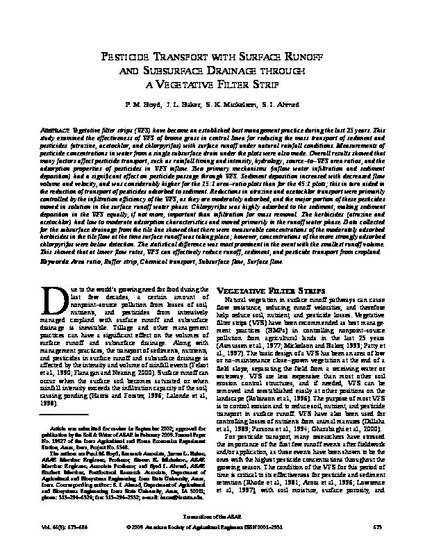
Vegetative filter strips (VFS) have become an established best management practice during the last 25 years. This study examined the effectiveness of VFS of brome grass in central Iowa for reducing the mass transport of sediment and pesticides (atrazine, acetochlor, and chlorpyrifos) with surface runoff under natural rainfall conditions. Measurements of pesticide concentrations in water from a single subsurface drain under the plots were also made. Overall results showed that many factors affect pesticide transport, such as rainfall timing and intensity, hydrology, source–to–VFS area ratios, and the adsorption properties of pesticides in VFS inflow. Two primary mechanisms (inflow water infiltration and sediment deposition) had a significant effect on pesticide passage through VFS. Sediment deposition increased with decreased flow volume and velocity, and was considerably higher for the 15:1 area–ratio plots than for the 45:1 plots; this in turn aided in the reduction of transport of pesticides adsorbed to sediment. Reductions in atrazine and acetochlor transport were primarily controlled by the infiltration efficiency of the VFS, as they are moderately adsorbed, and the major portion of these pesticides moved in solution in the surface runoff water phase. Chlorpyrifos was highly adsorbed to the sediment, making sediment deposition in the VFS equally, if not more, important than infiltration for mass removal. The herbicides (atrazine and acetochlor) had low to moderate adsorption characteristics and moved primarily in the runoff water phase. Data collected for the subsurface drainage from the tile line showed that there were measurable concentrations of the moderately adsorbed herbicides in the tile flow at the time surface runoff was taking place; however, concentrations of the more strongly adsorbed chlorpyrifos were below detection. The statistical difference was most prominent in the event with the smallest runoff volume. This showed that at lower flow rates, VFS can effectively reduce runoff, sediment, and pesticide transport from cropland.
Available at: http://works.bepress.com/steven_mickelson/21/

This article is from Transactions of the ASAE, 46, no. 3 (2003): 675–684.
Journal Paper No. 19827 of the Iowa Agricultural and Home Economics Experiment Station, Ames, Iowa, Project No. 6548.